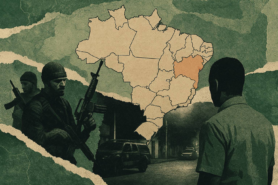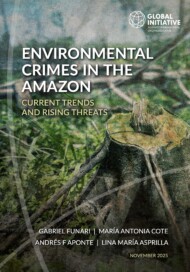On 15 September, Ruy Ferraz Fontes, São Paulo’s former police chief, was assassinated by three assailants using high-grade rifles in a busy road in the city of Praia Grande. Ongoing police investigations indicate that the Primeiro Comando da Capital (PCC) was behind the killing, reportedly in retaliation for Fontes’s long track record of combatting Brazil’s largest organized crime group.
Although there is a tendency to attribute blame to the PCC for all manner of crimes in Brazil, given Fontes’s career and the professional nature of the murder it is highly likely that this is the case. This is not the first assassination carried out by the PCC against a former law enforcement officer; the former head of a São Paulo prison was also killed in a similar fashion. Fontes’s murderers are still at large, but the police have identified seven suspects – two of whom are PCC members – who were reportedly involved in the killing.
The public murder of a senior police officer bears the hallmarks of a mafia killing, reflecting the PCC’s stature as a criminal behemoth intent on showing its strength. It also raises questions about how the state will respond to this demonstration of criminal prowess.
Settling an old score
Fontes was in charge of the first police task force that had investigated the PCC in the late 1990s, resulting in the arrests and indictments of the group’s leaders. In 2019, Fontes was responsible for transferring the PCC’s senior bosses from São Paulo-based penitentiaries to federal prisons scattered across Brazil in an attempt to dismantle the group’s chain of command. After retiring from the police in 2023, he became an official in the municipal government of Praia Grande, a city neighbouring Santos, the exit point for the bulk of the PCC’s cocaine exports to Europe and West Africa. Despite having faced death threats from the PCC since at least 2010, Fontes lost the right to a police escort after retiring.
Fontes’s murder is alarming because, in contrast to its arch-rival, the Comando Vermelho, the PCC has generally adopted a low-profile approach when it comes to confronting state forces, particularly over the last decade. Although the group was responsible for prison rebellions during the 1990s and early 2000s, and high-profile attacks on the police in São Paulo in 2006 and 2012, it has tended to operate under the radar so as to avoid courting police crackdowns, which would interfere with its lucrative and growing drug business.
This strategy has paid off handsomely. The PCC has become entrenched in densely populated neighbourhoods of São Paulo and other major Brazilian cities, including those in the Amazon region, setting up drug sale points, establishing rules of community conduct and playing the role of arbiter in settling local disputes. The organization has also become one of the world’s largest cocaine suppliers, with reportedly over 40 000 members active in 28 countries. The PCC has reinvested its drug money into a number of legitimate and illicit markets, including illicit gold mining, real estate and the fuel sector.
Getting away with murder?
Fontes’s assassination occurred in the wake of an unprecedented investigation into the PCC’s money laundering and market diversification initiatives. Just a few weeks prior, federal agents and local prosecutors had launched what is believed to be the largest organized crime investigation in Brazilian history, deploying 1 400 law enforcement officers across 10 Brazilian states. The operation, called Carbono Oculto (‘Hidden Carbon’), targeted the PCC’s involvement in the Brazilian fuel sector supply chain, including import, processing, distribution and retail. According to investigators, the PCC reinvested its proceeds from the fuel sector into at least 40 investment funds operated by prominent financial institutions. These funds held BRL30 billion (US$5.6 billion) in assets. Fontes’s assassination may signal that the PCC has decided to move away from its longstanding non-confrontational approach in an attempt to intimidate state authorities and prevent them from continuing to clamp down on the group’s financial operations.
While it is impossible to definitively establish the PCC’s intentions behind Fontes’s killing, the murder of a senior police officer in broad daylight threatens to unleash a spiral of violence. Over the past two years, São Paulo Governor Tarcísio de Freitas has pursued a tough public security strategy. Under his watch, police lethality in São Paulo increased by 61 per cent in 2024 with over 800 people killed in police operations – the largest increase among Brazil’s 27 states. The centrepiece of this aggressive policing strategy has been the coastal region around the port of Santos, a stronghold of the PCC. Over the course of 2023 and 2024, the São Paulo government launched two large-scale military police operations in the Santos region under the guise of combatting the PCC. These resulted in the deaths of at least 92 people, including unarmed civilians and a four-year-old boy. Cases of unlawful police violence in the Santos region were particularly acute following the killing of a police officer in the area in February 2024.
In this context, the prospect of a new wave of mass killings by the police to avenge Fontes cannot be ruled out. This would most likely result once again in the death of innocent civilians while failing to dismantle the PCC’s authority and power. Fontes’s assassination therefore exacerbates an already volatile situation involving a powerful criminal organization that appears to be increasingly willing to demonstrate its strength through public acts of violence, and a an increasingly lethal local police force . Rather than repeating failed interventions, state authorities should take inspiration from the Hidden Carbon operation. Large mafia-style groups such as the PCC are capable of withstanding coercive operations by state forces. Cutting off their sources of revenue and laundering mechanisms provides a more effective way to confront organized crime’s growing reach in Brazil.
O momento mafioso do PCC: O assassinato de um chefe de polícia revela o crescente poder do PCC
Em 15 de setembro, Ruy Ferraz Fontes, ex-delegado geral da Polícia Civil de São Paulo, foi assassinado por três agressores usando fuzis de alta potência em uma rua movimentada em Praia Grande. Investigações policiais em andamento indicam que o Primeiro Comando da Capital (PCC) está por trás do assassinato, supostamente em retaliação ao longo histórico de Fontes no combate ao maior grupo criminal do Brasil.
Embora haja uma tendência de culpar o PCC por vários tipos de crimes no Brasil, dada a carreira de Fontes e a natureza profissional do assassinato, é altamente provável que a facção esteja envolvida. Este não é o primeiro assassinato cometido pelo PCC contra um agente de segurança pública; o ex-chefe do presídio de Carandiru também foi morto de maneira semelhante. Os assassinos de Fontes ainda estão foragidos, mas a polícia identificou sete suspeitos — dois dos quais são membros do PCC — que teriam participado do crime.
O assassinato público de um policial de destaque se assemelha ao um ato mafioso, refletindo a estatura do PCC como uma potência criminal empenhada em mostrar seu poder. Isso também levanta questões sobre como as instituições estatais responderão a essa demonstração de poderio criminoso.
Acertando contas antigas
Fontes foi responsável pela primeira força-tarefa da Polícia Civil paulista que investigou o PCC no final da década de 1990, resultando na prisão e indiciamento dos líderes do grupo. Em 2019, Fontes foi responsável pela transferência dos chefes do PCC de penitenciárias em São Paulo para prisões federais espalhadas por todo o Brasil, numa tentativa de desmantelar a cadeia de comando do grupo. Após se aposentar da polícia em 2023, ele se tornou o secretário de Administração da prefeitura de Praia Grande, cidade vizinha a Santos, ponto de saída da maior parte das exportações de cocaína do PCC para a Europa e a África Ocidental. Apesar de ter recebido ameaças de morte do PCC desde pelo menos 2010, Fontes perdeu o direito à escolta policial após se aposentar.
O assassinato de Fontes é chocante porque, em contraste com outras organizações criminosas como o Comando Vermelho, o PCC geralmente tem evitado confrontar forças estatais, especialmente durante a última década. Embora o PCC tenha sido responsável por rebeliões em presídios durante os anos 1990 e início dos anos 2000, e por ataques de grande repercussão contra a polícia em São Paulo em 2006 e 2012, a facção tem evitado embates que poderiam levar a intervenções policiais prejudiciais ao seu lucrativo e crescente negócio de drogas.
Essa estratégia rendeu bons frutos. O PCC se consolidou na região metropolitana de São Paulo e em outras grandes cidades brasileiras, inclusive na região amazônica, criando pontos de venda de drogas, estabelecendo regras de conduta e mediando disputas locais. A organização também se tornou uma das maiores fornecedoras de cocaína do mundo, com mais de 40 mil membros ativos em 28 países, segundo relatos. O PCC reinvestiu o dinheiro proveniente do tráfico de drogas em vários mercados legítimos e ilícitos, incluindo mineração ilegal de ouro, imóveis e o setor de combustíveis.
Impunidade e a perpetuação de ciclos de violência
O assassinato de Fontes ocorreu logo após o lançamento de uma investigação sem precedentes sobre as iniciativas do PCC para lavar seus ganhos ilícitos e diversificar as suas fontes renda. Apenas algumas semanas antes do assassinato, agentes federais e promotores paulistas haviam lançado o que se acredita ser a maior investigação contra o crime organizado da história do Brasil, mobilizando 1 400 agentes de segurança pública em 10 estados. A operação, chamada Carbono Oculto, tinha como alvo o envolvimento do PCC em todas as partes do setor de combustíveis brasileiro, incluindo importação, processamento, distribuição e varejo. De acordo com os investigadores, o PCC reinvestiu seus lucros do setor de combustíveis em pelo menos 40 fundos de investimento operados por instituições financeiras de destaque. Esses fundos detinham R$30 bilhões em ativos. O assassinato de Fontes pode sinalizar que após o lançamento da investigação, o PCC decidiu abandonar sua estratégia de não-enfrentamento para agora passar a intimidar autoridades estatais e impedi-las de continuar reprimindo as operações financeiras do grupo.
Embora seja impossível pontuar com certeza neste momento as intenções do PCC por trás do assassinato de Fontes, o homicídio de um policial proeminente em plena luz do dia ameaça desencadear uma espiral de violência. Nos últimos dois anos, o governador de São Paulo, Tarcísio de Freitas, adotou uma estratégia linha-dura de segurança pública. Sob sua gestão, a letalidade policial em São Paulo aumentou 61% em 2024, com mais de 800 pessoas mortas por policiais – o maior aumento entre os 27 estados do Brasil. O epicentro dessa estratégia de segurança pública tem sido a Baixada Santista, um reduto do PCC. Ao longo de 2023 e 2024, o governo de São Paulo lançou duas operações policiais militares em grande escala na região de Santos, sob o pretexto de combater o PCC. Elas resultaram na morte de pelo menos 92 pessoas, incluindo civis desarmados e um menino de quatro anos. Os casos de violência policial na Baixada Santista se tornaram ainda mais graves após o assassinato de um policial na região em fevereiro de 2024.
Nesse contexto, não se pode descartar a possibilidade de uma nova onda de violência policial para vingar Fontes. Essa estratégia seria ineficaz para desmantelar a autoridade e o poder do PCC e provavelmente resultaria, mais uma vez, na morte de civis inocentes. O assassinato de Fontes portanto agrava o cenário já existente: por um lado uma poderosa organização criminosa que parece estar disposta, cada vez mais, a demonstrar sua força por meio de atos públicos de violência e por outro uma força policial cada vez mais letal. Em vez de repetir intervenções fracassadas, as autoridades estaduais deveriam se inspirar na Operação Carbono Oculto. Grandes grupos mafiosos, como o PCC, são capazes de resistir a operações coercitivas do Estado. Cortar suas fontes de receita e mecanismos de lavagem de dinheiro é uma maneira mais eficaz de enfrentar o alcance crescente do crime organizado no Brasil.



